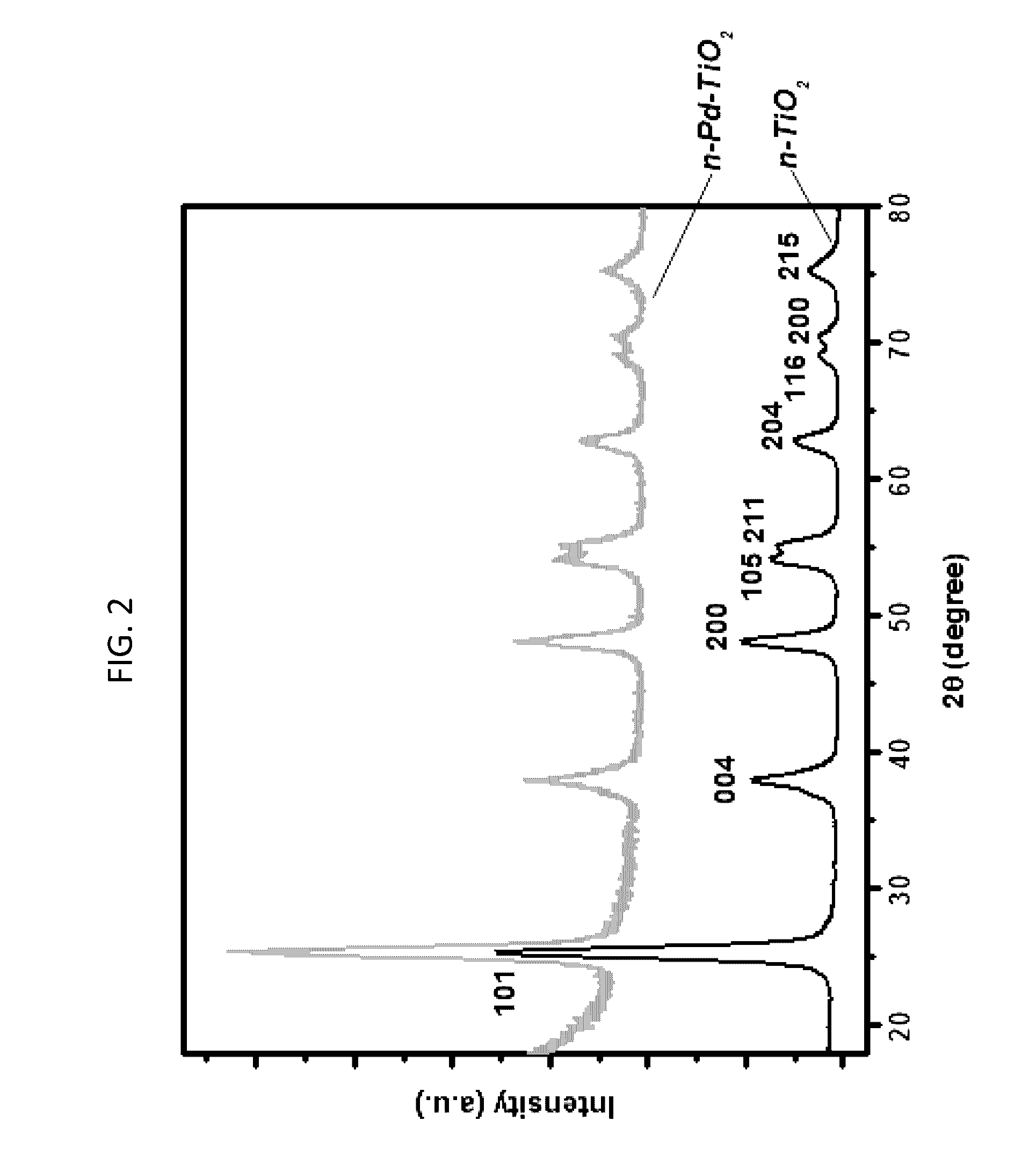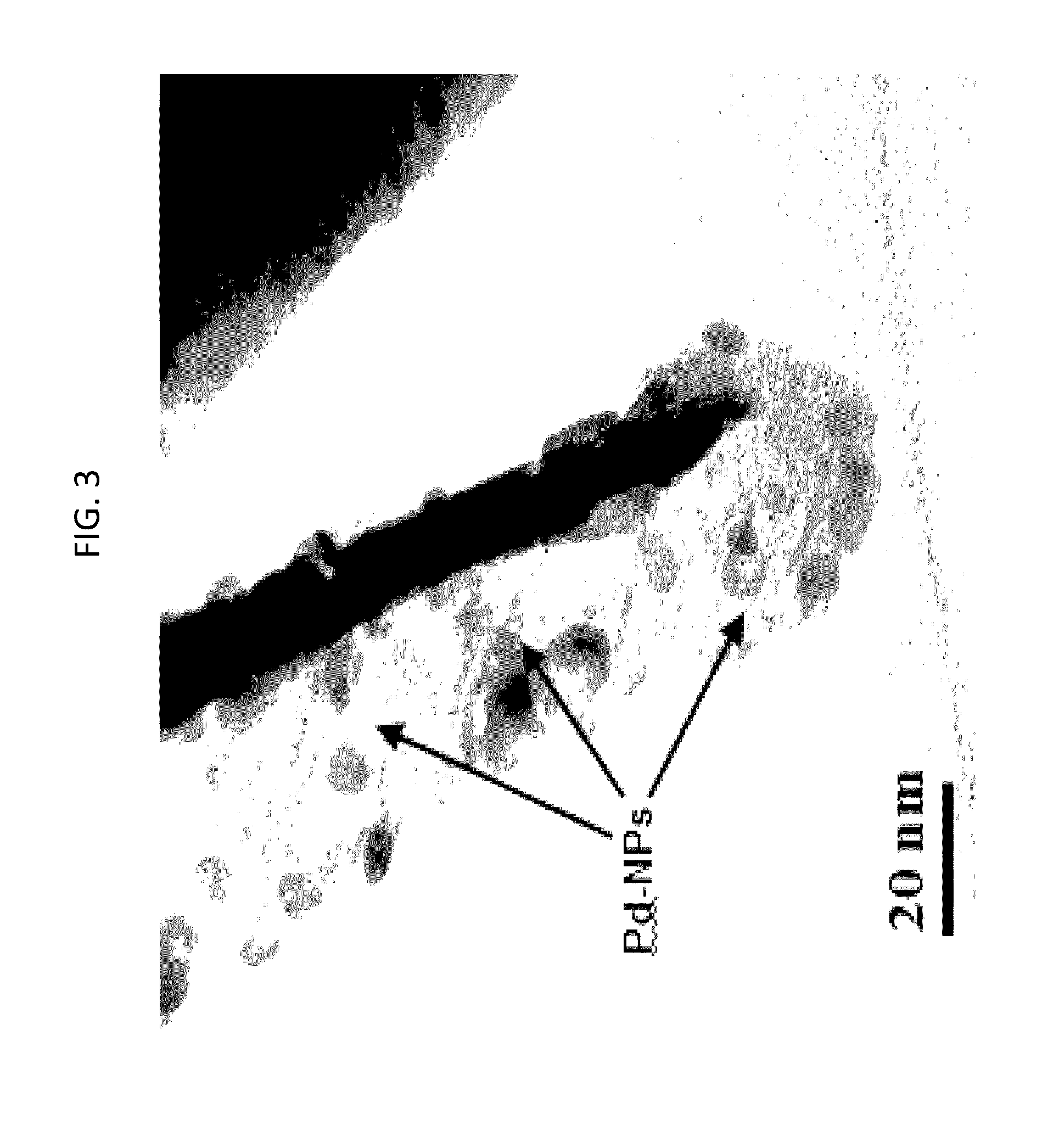Method for disinfecting a fluid with a palladium-doped tungsten trioxide photo-catalyst
a technology of tungsten trioxide and photocatalyst, which is applied in the direction of water/sludge/sewage treatment, water treatment compounds, specific water treatment objectives, etc., can solve the problems of increasing corrosiveness, transferring contaminated substances from treated water, and leaving toxic residual chlorine in treated water
- Summary
- Abstract
- Description
- Claims
- Application Information
AI Technical Summary
Benefits of technology
Problems solved by technology
Method used
Image
Examples
example 1
Materials and Methods
1. Synthesis of the Nano Photo-Catalysts
[0092]Pure WO3 nanoparticles (n-WO3) were prepared by precipitation method as reported by Supothina et al (See S. Supothina, P. Seeharaj, S. Yoriya and M. Sriyudthsak, Ceram. Int., 2007, 33, 931-936, incorporated herein by reference in its entirety). Briefly, pre-determined amount of ammonium tungstate pentahydrate ((NH4)10—W12O41.5H2O) was dissolved in deionized water by heating at 85° C. and this was followed by dropwise addition of warm and concentrated nitric acid (HNO3, Merck) with vigorous stirring. The obtained precipitates, after settling down for 24 hours, were thoroughly washed with deionized water. Finally, the precipitates were filtered by centrifugation, dried and calcined at 500° C. for 6 h at a ramp rate of 1° C. min−1. TiO2 nanoparticles (n-TiO2) were synthesized by using decomposition-precipitation technique. Specifically, a titanium (III) sulfate solution (Sigma-Aldrich) was added into hot sulfuric acid. ...
example 2
Characterization of the Photo-Catalysts
1. Morphological Characterization of the Photo-Catalysts
[0096]The XRD patterns for the synthesized n-WO3 and n-Pd / WO3 are presented in FIG. 1. All the main indexed peaks were fitted to the hexagonal WO3 system (JCPDS card 35-1001). Higher diffraction coming from [001] compared with other planes suggests that [001] is the major growth direction. After n-Pd loading on n-WO3, no change in XRD pattern was noticed, indicating the material is of a single phase and is impurity free. The Pd diffraction not appearing in the XRD pattern could be due to a high dispersion and a low loading (around 1 wt %) of Pd nanoparticles on the n-WO3. However, the crystallinity of n-Pd / WO3 was reduced probably due to the dispersed palladium covering n-WO3. The XRD patterns of n-TiO2 and n-Pd / TiO2 are presented in FIG. 2. All the peaks can be indexed to anatase phase of TiO2, and the [101] is the major growth zone. After n-Pd loading, no extra peak was noticed probably ...
example 3
Photocatalytic Deactivation of SRB Using the n-WO3, n-Pd / WO3, n-TiO2, and n-Pd / TiO2 Photo-Catalyst
[0098]FIG. 10 is a typical exponential decay curve of SRB representing the fastest SRB deactivation process obtained while using 1.5 mg / ml of n-Pd / WO3 with a laser radiation at 355 nm in wavelength and at 40 mJ per pulse energy. The rate of deactivation of SRB was conveniently quantified in terms of the decay rate constant k (i.e. the slope of the linear lnN / N0 versus time plot, where N is the number of SRB at time t and N0 is the initial number of SRB) in the units of minute−1 and the total depletion time td (time required for the complete depletion) in the units of minutes. FIG. 11 indicates that the rate of SRB deactivation depended on the n-Pd / WO3 concentrations. Specifically, the decay rate constant initially increased with the increasing concentration of n-Pd / WO3, reached the maximum when the concentration of n-Pd / WO3 was at 1.5 mg / ml, and started to decline when the concentration...
PUM
 Login to View More
Login to View More Abstract
Description
Claims
Application Information
 Login to View More
Login to View More - R&D
- Intellectual Property
- Life Sciences
- Materials
- Tech Scout
- Unparalleled Data Quality
- Higher Quality Content
- 60% Fewer Hallucinations
Browse by: Latest US Patents, China's latest patents, Technical Efficacy Thesaurus, Application Domain, Technology Topic, Popular Technical Reports.
© 2025 PatSnap. All rights reserved.Legal|Privacy policy|Modern Slavery Act Transparency Statement|Sitemap|About US| Contact US: help@patsnap.com



